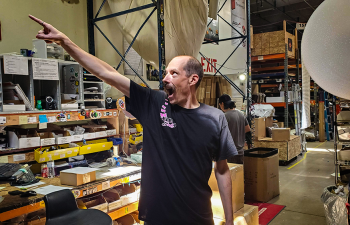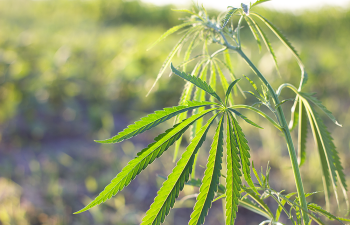Through a Glass Darkly: Making Sense of the Pipe Market
Sales of glass pipes have taken a severe hit over the past year. Veteran glass blower, Scott Torry of Murky Waters Studio tackles the delicate question of why.
From small sheds and garages to schoolies and warehouses, the art of the glass pipe has evolved and made its way through the decades with major crests and troughs along the way. Prohibition against cannabis wasn’t limited to the plant; glass went right alongside it as paraphernalia was also illegal to possess, a fact that still stains the records of more veteran artists than I could count. Granted, compared to the herb itself, pipe prohibition came with an impressively elastic loophole, but that loophole could snap shut without warning at any moment—and it often did.
Our world has changed. The same laws governing so-called “paraphernalia” are still on the books, but the previous decade’s tsunami of legalization has rendered them nearly unenforceable. As a result, we now have a generation of incoming artists who have no firsthand experience of the criminalization of their art. The concept floats around, but it’s like the dry counties of the Bible Belt; more or less a myth until we accidentally drive through one.
It was the so-called “degenerates,” though—the ones who were willing to engage in a criminalized act of creation—who took the artform from the jam lot blankets to museums and galleries, transforming the creation from “just a pipe” to a work of transcendence.
It was the so-called “degenerates,” though—the ones who were willing to engage in a criminalized act of creation—who took the artform from the jam lot blankets to museums and galleries, transforming the creation from “just a pipe” to a work of transcendence. They went so far as to turn the heads of long-time artists from outside the culture, who for years, dismissed pipe art altogether, attaching “if it wasn’t for that bowl’’ to any positive words they could offer. It should be noted that many of these naysaying veteran flame workers would eventually go on to make pipe art of their own, justifying the about-face by re-labeling their work “interpretations of a pipe.” Now, having ventured from the shadows, heady glass pipes have made such a mark on culture that they’ve added words to our lexicon—terms that continually evolve with color pallets, techniques and execution.
Many of us who have observed or have been a part of the ride from the beginning remain nostalgic for those early days when the artform carried risk—and rightfully so. In any space, risk works as a sieve to filter out the opportunists and hacks. Add to that, the uncertainty that the artform would ever escape the shadow of prohibition. Marginalization often fosters cohesiveness, a trait easily lost when the exterior pressures shift.
Despite those concerns and misgivings, we’ve celebrated every victory for legalization that has appeared on our newsfeeds, first with medical, then recreational, and have looked forward to the inevitable day when the federal ban will be repealed altogether. What we lose in a cohesive community, we’ll gain in new opportunities and wider horizons. Or, so we thought.
In 2020, the music stopped, so to speak. Festivals, events, gatherings, concerts–even the local sesh–they were all put on hold. It can’t be overlooked that this has made permanent changes to the landscape. However, the economy is now running hot and we still face a problem of slumping sales. So again: Why?
For the past month, I’ve been speaking with glass blowers and distributors around the country, tallying up their individual accounts in hopes of getting a glimpse of the big picture of where we are and where we’re going. One thing is overwhelmingly clear: Something happened in 2023. It was subtle, but it was massive and in my opinion, its reverberations will have even more of a lasting effect than that of the pandemic. We all felt it, but individually it was hard to pinpoint. Most distributors agreed shops were being more cautious than they had been in previous years. They weren’t shying away from high end pieces altogether, but they were being more selective in the styles they brought and less likely to buy in the quantities to which we’ve become accustomed. It’s hard to pin a direct cause to this, but the overall sentiment has been that the customer base for glass has narrowed–and when a customer base narrows, sales drop, bottom line.
How could that happen? On its surface, it makes no sense. Legalization should be blowing the market for accessories wide open, yet here we are. Is the hesitation from the market itself or from the people in the market? Meaning, are we looking at an issue of macroeconomics or consumer choice? The pandemic was an issue of macroeconomics. Business came to a stand still and unemployment went through the roof as we placed ourselves in a sort of artificial recession.
But that’s not the case today. Granted, we’re still feeling the reverberations from the pandemic. In 2020, the music stopped, so to speak. Festivals, events, gatherings, concerts–even the local sesh–they were all put on hold. It can’t be overlooked that this has made permanent changes to the landscape. However, the economy is now running hot and we still face a problem of slumping sales. So again: Why?
No longer being the social creatures we once were, we’re now even less likely to engage in those group sessions where the “sacred vessel” is being passed around. We’re more than likely laying in bed, streaming Netflix and puffing on a cart purchased at the local dispensary while sliding into the DMs of our buds.
We won’t be able to answer this question definitively, but we can at least put a sizable dent in the mystery. Let’s start by looking at the pandemic one more time and consider what those lasting effects actually were. A lot could be explored here, but the overarching pattern of interest is our collective capacity for socialization dropped. And while it did tick back up as we emerged from our caves, I think it’s safe to say that we never fully recovered. Why does that matter? I’ll get to that in a minute.
Meanwhile, as already addressed, state-by-state legalization is now truly hitting its full stride, and within that, there has been an unexpected shift in preference of consumption methods. Since cannabis has lost its status as a forbidden fruit, it appears that its consumption is now far more about efficiency than community. Glass pipes, especially the high-end, have a communal—some would even say sacramental—nature to them. They’re best enjoyed in groups, where beauty of the art is shared and enjoyed as much as the herb in the bowl–and traditionally, the communal aspect was as much about that enjoyment as it was about the sharing in something forbidden.
Now, let’s bring back the effects of the pandemic. No longer being the social creatures we once were, we’re now even less likely to engage in those group sessions where the “sacred vessel” is being passed around. We’re more than likely laying in bed, streaming Netflix and puffing on a cart purchased at the local dispensary while sliding into the DMs of our buds. It’s a different world–and (it can be argued) not exactly one conducive to the sale of glass.
That’s a bitter pill to swallow. I should know–this is my livelihood, and it supports my family.
There is no short answer to this multifaceted dilemma. We need to think rationally and strategically to ensure not only our individual survival, but that of the collective as well.
The good news is there is hope. Pipe art isn’t going away; it just might slim down for the time being. We’ll get into that more in that in the next installment, as well as take a look at strategies for weathering the shifts in the market. Stay tuned; we’re getting into the weeds with this.
By Phillip Scott Torry
Edited and co-written by David Pogge
Philip Scott Torry (PSTglass) brings 17 years of glassblowing experience to Murky Waters Studio. With his rebellious spirit and touch of quirkiness, he embraces the counter culture while pursuing his business built on family values. Aside from work, he enjoys long walks on the beach and fat dabs. 5 kids, Catholic.
Editor’s Note: The idea for this article partially arose from a discussion about “Marijuana Isn’t Cool Anymore,” the op-ed by Bruce Reith published in our August issue. Admittedly, we may have borrowed some of his thoughts in the arguments set forth here. Can you blame us? They were really good thoughts.










